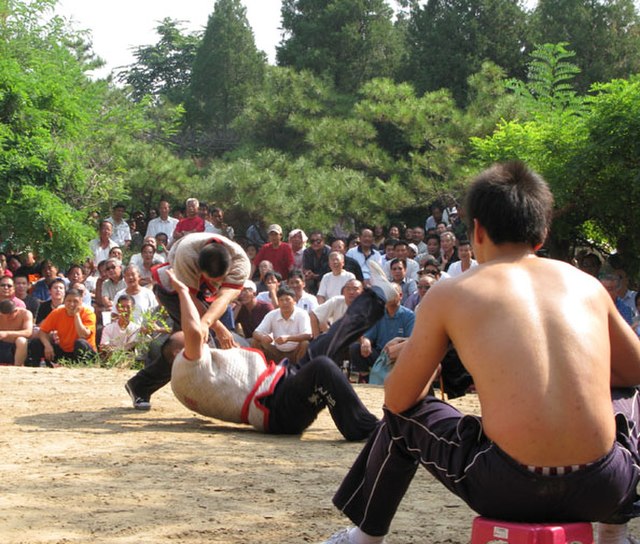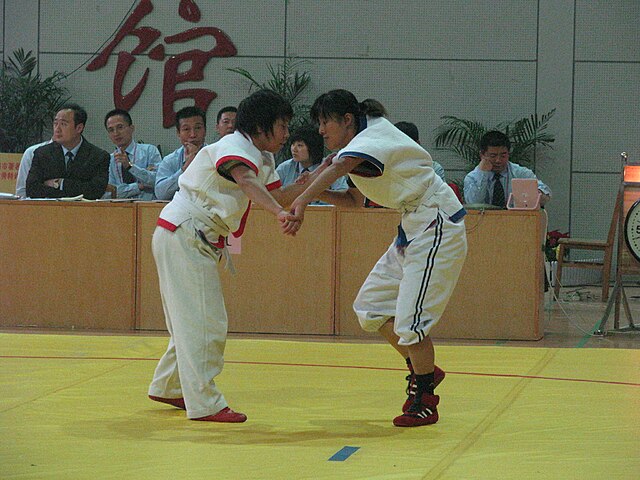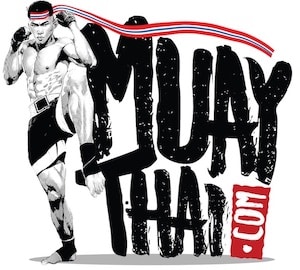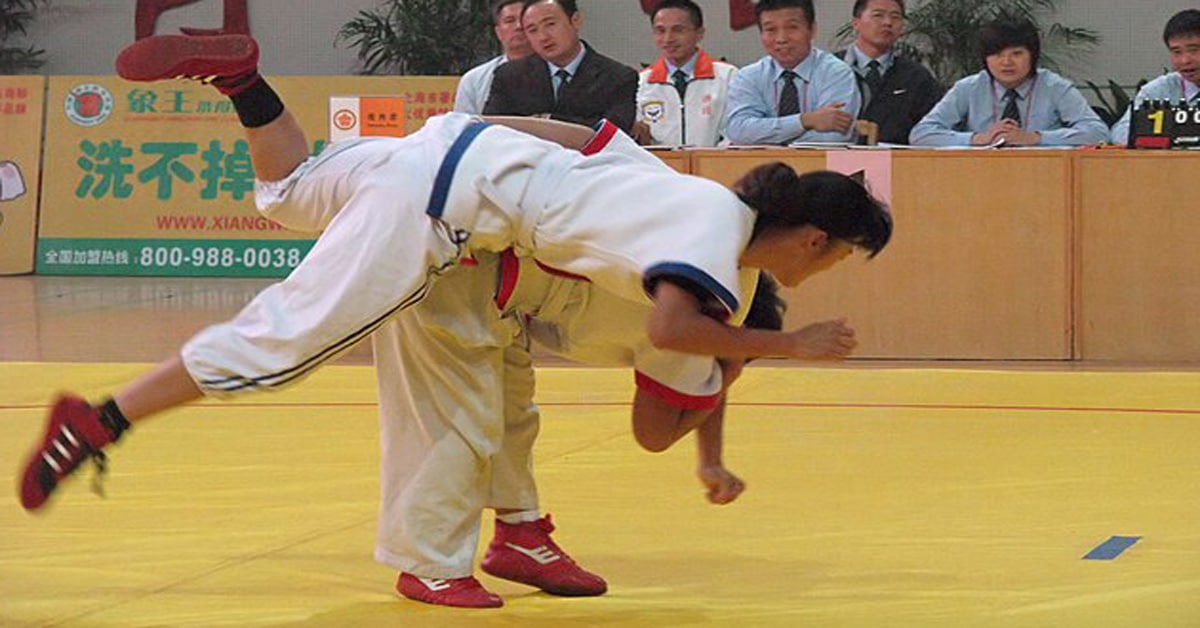Shuai Jiao: Chinese Jacket Wrestling
Many out there believe jacket wrestling started with Judo. In China, another far older form of jacket wrestling is practiced called “Shuai Jiao.”
Here is a breakdown of the Chinese style of jacket wrestling called Shuai Jiao. Below is a summary of the wrestling style’s history, techniques, uniforms, and rules.

What is Shuai Jiao?
Chinese wrestling, or Shuai Chiao (Shuai Jiao), is a form of jacket wrestling developed within China. Six thousand years of history led to the modern style being developed.
The term “Shuai Jiao” was first used in 1928 by the Central Guoshu Academy of Nanjing. One of the national martial arts academies within China.
The History of Shuai Jiao
The history of Shuai Jiao dates back over six thousand years ago. It descended from an ancient Chinese wrestling style called “Jiao Di,” which translates to “horse-butting.”
This style of wrestling was practiced within ancient Chinese military academies. Soldiers wore horned helmets and rammed into each other as they attempted to throw them to the ground.
Chinese legend says that the deity Yellow Emperor was a practitioner of this wrestling style. Another style of Chinese wrestling called “Jiao Li” is believed to have influenced the art of Shuai Jiao.
Jiao Li was a wrestling style developed during the Zhou dynasty. It’s a grappling art that teaches many of the same techniques as Shuai Jiao, along with striking and pressure point holds.

The Modernization
The modernization of Shuai Jiao began in the early 1900s. By 1917, wrestling was included in the Central Guoshu Academy, a national martial arts academy within the Nanjing Province.
Over the next decade, administrators began codifying and creating official rules and regulations for Chinese wrestling. In 1928, they agreed to call this form of wrestling Shuai Jiao.
Then, in 1935, the first Chinese national Shuaijiao competition was held. Within China, Shuai Jiao is widely taught to government employees, from soldiers to police officers.
Shuai Jiao Techniques
If you’re familiar with Judo techniques, you will notice many of the same techniques within Shuai Jiao. Controlling an opponent with their Gi top to break their base or posture to execute different throws and trips.
Of course, within Shuai Jiao, the names of the techniques are different and have slight variations in the details. The techniques of Chinese jacket wrestling are also much older than its Japanese cousin.
Uniform
The uniform of a Shuai Jiao practitioner consists of four different pieces of clothing.
- Shuai Jiao (Gi Jacket)
- Shuai Jiao Kuzi (Gi Pants)
- Wrestling Shoes
- Belt
The Shuai Jiao Gi is a short-sleeved shirt with an open chest. It looks like a mix of a Karate Gi and a Mongolian wrestling top. These jackets come in solid colors or white with a colored trim.
A belt representing the practitioner’s rank is worn around the abdomen. Gi pants and wrestling shoes are also part of the official Shuai Jiao uniform,
The Shuai Jiao Belt System
Shuai Jiao uses a unique belt system that consists of seven different ranks.
- White Belt
- Green Belt
- Green-Blue Belt
- Blue 1
- Blue 2
- Blue 3
- Black Belt
It can take anywhere from five to ten years to earn a black belt in Chinese jacket wrestling. Around the same time frame to earn a black belt in Judo or BJJ.
Shuai Jiao Rules Sets
Some different Shuai Jiao organizations have their own rules, but many follow them for state-sanctioned competitions. Here is the general rule set used for Chinese jacket wrestling competitions.
- 2 Rounds/3 Mins (Women’s Matches are 2 Mins)
- Tiebreaker Round: 90 seconds
- Win by earning the most points.
- A competitor that gains a 6-point lead automatically wins the round.
Under this rule set, a tiebreaker round will be implemented if there is no winner during regulations. If no one scores during the tie-breaker round, more rounds will be added until a winner emerges. There are no ties within this form of Shuai Jiao.
The point system of Shuai Jiao looks like this:
- 3 Points: A perfect throw with an opponent on their back.
- 2 Points: Two-point throws are where both knees, hands, elbows, or one of each of an opponent touches the mat. Throws must also remain on their feet in order to be awarded 2 points.
- 1 Point: One hand, knee, or elbow touches the mat during a throw. One point is also given if the thrower leaves their feet or if their opponent steps out of bounds.
Notably, earlier Chinese Jacket wrestling formats went by a best two out of three falls format.
Shuai Jiao vs. Judo
Shuai Jiao makes a lot of comparisons to the Japanese grappling arts of Judo. Here are some of their similarities and differences.
Nations
The most obvious difference between the two styles is their nation of origin. Shuai Jiao is a Chinese grappling style, and Judo is a Japanese grappling style.
Uniforms
The uniforms worn in both forms of jacket wrestling are completely different. The Judogi used in Judo is long-sleeved and made of stronger and thicker material. A Shuai Jiao Gi jacket looks more like a Karate jacket.
Permitted Techniques
While many of the techniques of these grappling arts look the same, they do have some differences. Some of the techniques in Shuai Jiao are illegal in Judo and vice-versa.
For example, you can touch your opponent’s legs in Chinese jacket wrestling. Modern Judo practitioners can no longer grab below their opponent’s waist.
Rule Sets
Competitions of these two grappling styles are much different than the other. Everything from the techniques permitted time and point systems are different.
The rules of Shuai Jiao were already mentioned before, so here’s a quick explanation of the rules in Judo. A Judo match ends when an athlete executes a perfect technique, where their opponent hits flat on the mat. A perfect throw does not end a Shuai Jiao match.
Shuai Jiao is Older
We also have to mention that Shuaijiao is much older than its Japanese cousin. The techniques of Chinese jacket wrestling are far older than the techniques used in Judo. It also most likely influenced styles of Japanese Jujutsu, which Judo descended from.
Shuai Jiao Hip Throw
We found this great breakdown on YouTube to give you an example of a Shuai Jiao hip throw. Here’s a detailed breakdown of how to do this technique
This Chinese Jacket wrestling hip throw setup starts with a single-sleeve grip. Your opponent will have a collar tie, and you will use the sleeve grip to counter this sleeve grip.
Just like doing an Ippon Seoi-Nage, you pull your opponent forward with your grip as you step in. Complete the back step and turn as you lower yourself under your opponent’s hips to load them.
When you load your opponent, you will up their armpit, straighten your arm, and take them over.
Is Shuai Jiao An Effective Martial Art?
Shuai Jiao is an effective martial art on the level of Judo. The techniques are proven effective with centuries of evolution to create the style of Chinese jacket wrestling used today. Skills in this martial art can easily translate to competing in other styles like Judo or MMA.


